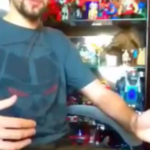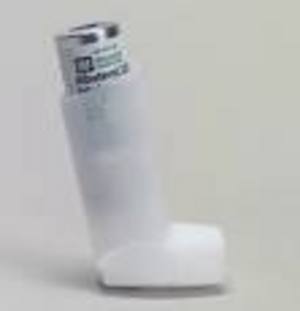Rob Zombie, who’s given name is Robert Cummings, was born on January 12, 1965 in Haverhill, Massachusetts. Cummings was always fascinated with the classic movie monsters, wrestling, comics, the 1960’s gore movies, and any other form of the counter-culture art movement. Throughout his musical career Cummings would draw inspiration for his music and design from these art forms. Robert Cummings and his younger brother Michael Cummings (better known as Spider One, vocalist for Powerman 5000), became interested in design at an early age and Rob soon moved to New York, where he began to pursue a career in publishing at the Pratt Institute.
During his time at the Pratt Institute, Cummings worked a variety of jobs, including working as a cycle courier and as a designer for pornographic magazines. Perhaps his most famous job was as a production assistant on the hit children’s TV show Pee-Wee’s Playhouse. It was during this time that Cummings met and began dating another young designer by the name of Shauna Reynolds. Reynolds shared the same interest in classic horror, sci-fi, and heavy metal that Cummings did and it didn’t take long before the couple decided to form a band. There was a minor problem however – neither Cummings nor Reynolds were musicians. The two friends decided to split the two duties they each had an interest in: Cummings changed his name to Rob Straker and became the vocalist while Reynolds changed her name to Sean Yseult and became the bassist. For the name of the band they chose the classic black-and-white Bela Lugosi shocker White Zombie.
Straker and Yseult quickly added lead guitarist Paul Ena Kostabi and drummer Peter Landau to complete the line-up and began doing shows around New York. White Zombie was originally just a noise band, much like fellow New Yorkers Sonic Youth. White Zombie finally released their first EP, Gods on Voodoo Moon, toward the end of 1985 through independent label Silent Explosion. The EP wasn’t successful, only 100 of the original 300 copies sold and the members of White Zombie still retain the remaining 200 copies to this day. Following a disagreement both Kostabi and Landau were fired from White Zombie soon after the EP’s release. Drummer Ivan de Prume and guitarist Tom Guay were hired to replace them.
Gods on Voodoo Moon was followed up with 2 more EPs, Pig Heaven in 1986 and Psycho-Head Blowout in 1987, both still on Silent Explosion. 1987 also saw the release of the band’s first full album on Silent Explosion, Soul-Crusher. In 1988, White Zombie re-released Soul-Crusher on Caroline Records, a punk rock label. The most important change during this re-release was that Cummings finally made the change to the name that has stuck with him for almost 2 decades, Rob Zombie.
In 1989 John Ricci took over guitar for Guay and White Zombie released their second full length album on Caroline Records, Make them Die Slowly. While neither album helped the band gain much mainstream publicity, Make them Die Slowly fared better and was more accepted. It also marked White Zombie’s turn from punk rock to the strong heavy metal style that would stay with them and carry into Rob Zombie’s solo work. Ricci left soon after the album’s release and Jay Yuenger was brought in as his replacement. In October of 1989, White Zombie released the EP that would get them noticed by the rest of the music world, God of Thunder. The EP, which consisted of a cover of the KISS song “God of Thunder”, an original song titled “Love Razor”, and a rework of “Disaster Blaster” from Make them Die Slowly, received heavy airplay and caused the band to get noticed and eventually signed by Geffen Records. It was obvious that as the sole song writer and the man behind White Zombie’s artwork, Rob was the primary force in bringing the entire band to Geffen.
In 1992 White Zombie released their major label debut, La Sexorcisto Devil Music, Vol. 1, on Geffen Records. The album was an immediate success, making it’s way to Number 2 on the Billboard Heatseakers chart and Number 26 on the Billboard Top 200 and was certified double platinum. The album also produced two Top 50 singles on the Mainstreak Rock tracks chart, “Thunder Kiss ’65” hit Number 14 and “Black Sunshine” hit Number 39. Rob’s creativeness didn’t just come out in his lyrics on the album, he’s also credited with the cover art and the booklet illustrations for the entire album. He also co-directed the band’s first video, “Thunder Kiss ’65”, which saw Rob use cartoon horror and reinforced the “acid trip feel” of the band. The video was set in the desert and made use of Night of the Living Dead-style zombies, Frankenstein’s Monster, and Go-Go Dancers. Although Rob didn’t direct the video to “Black Sunshine” he’s since directed the video for every one of his songs.
The success of the album and the band’s showmanship during concerts helped propel White Zombie out of the cult scene and turned them into a stadium band. It was during the touring for this album that Zombie and Yseult’s personal relationship came to an end but their professional relationship would continue for a few more years.
It wasn’t long after the La Sexorcisto Tour ended that White Zombie began work on their second Geffen album. By the time they actually entered the studio, John Tempesta was brought in to play drums, taking Phil Buerstatte’s spot after he’d replaced Ivan de Prume during the La Sexorcisto Tour. The music was all credited to White Zombie for this album with Rob producing all the lyrics and sleeve art as usual. Rob Zombie also submitted a 16-page CD book that he’d, once again, designed himself and after label head David Geffen only agreed to pay for 4-pages, Rob himself supplied the money to pay for the other 12 instead of reaching a compromise. The recording sessions for this 2nd Geffen album were plagued with problems, mostly because the label was having problems securing the rights to samples from horror movies that the band had wanted to use in the songs. In response to this, Rob Zombie entered the studio and produced his own samples from fictitious B-movies for the songs to use.
The other members of the band began to outwardly express that they didn’t always understand Rob’s vision, noting that the actual song recordings were done and they were just waiting for Rob and the producers to put it all together. Finally in April of 1995 Astro-Creep 2000: Songs of Love, Destruction, and Other Synthetic Delusions of the Electric Head was released and hit the Billboard Top 200 at Number 6 soon afterwords. Musically, the songs on Astro-Creep were much darker than those on La Sexorcisto, dealing with murder, death, blasphemy, Satanic rituals, and the undead among other things. The guitars and bass were also tuned-down alot more than they were on the previous White Zombie releases, allowing the tones to match the darker lyrics. Since it’s release Astro-Creep 2000 has been certified double platinum, selling over 2.6 million copies. Due to it’s initial success, a reprint was made that saw 50,000 copies of the album pressed onto see through blue vinyl.
Astro-Creep would be White Zombie’s final album of new material as Rob began to break away from the rest of the band and establish his own career. He animated the psychedelic trip sequence in 1996’s Beavis & Butt-head Do America and was approached to direct the third movie in the comic-franchise The Crow but his script was ultimately rejected. He won the award for Best Music Video at the 1995 MTV Video Music Awards for directing White Zombie’s “More Human than Human”. He also collaborated with his childhood inspiration Alice Cooper on the song “Hands of Death (Burn Baby Burn)” for the X-Files soundtrack Songs in the Key of X, released in 1996.
In 1998 he created his own record label, Zombie-A-Go-Go and signed acts that weren’t usually associated with mainstream heavy metal, focusing on surf and shockrock. He compiled a sampler CD, Halloween Hootenany, featuring bands on his label and released in in October of 1998. He also began managing his brother Spider’s band, Powerman 5000, as well as working on his solo debut.
In August of 1998, Hellbilly Deluxe: 13 Tales of Cadaverous Cavorting Inside the Spookshow International was released to critical praise. Although some look at the album as a newer version of White Zombie, the album was Rob’s own. Without the rest of the band to reign Rob in he had complete control over the final product and produced an album that went on sell over 3,000,000 copies in the US alone, debuting at Number 5 on the Billboard Top 200. This album also marked the beginning of his public relationship with longtime girlfriend Sheri Moon and also the official end of White Zombie. Rob Zombie would direct 3 videos from Hellbilly Deluxe, “Dragula” and “Living Dead Girl” in late ’98 and “Superbeast” in early ’99. A remix of “Dragula” was also included on the soundtrack to the box office hit The Matrix.
After finishing the Hellbilly Deluxe Tour in 1999 Rob Zombie was approached by Universal Studios with 2 requests, they wanted to capitalize on the recent re-interest in horror movies brought on by the remake of The Texas Chainsaw Massacre and the icon-combining Freddy -vs- Jason. They wanted Rob Zombie to design a maze for their Halloween Horrors 1999 event and also wanted him to write and direct an “old-school” horror movie for them. To hold his music fans over Zombie went back into the studio and produced American Made Music to Strip By, a rework of Hellbilly Deluxe with remixes on all the songs. He then designed Universal’s maze and began writing the script for his movie, House of 1000 Corpses. The movie began production in April 2000 and finished shooting on August 14, 2000 with the idea of having the movie in theaters in time for Halloween. Zombie even created a second Halloween maze for Universal, hoping to continue the working relationship.
What Universal got from House of 1000 Corpses was far from what they were expecting, the modern day “MTV-era” slick horror movies. Instead Zombie produced a horror movie that looked more underground, and suitable for drive-ins and was obviously influenced by movies like Natural Born Killers and the Faces of Death franchise. Universal shelved the rough cut of the film, fearing an NC-17 rating. The film wouldn’t see daylight for 3 years.
After his “unsuccessful” trip into movie land Rob went back to work in the studio, preparing for his second solo album, The Sinister Urge, released in 2001. What came out of the studio was a more refined sound that was still all Zombie. Rob Zombie incorporated horn instruments into several songs and even recorded what can be considered a soft ballad with “(go to) California”. The album also contained more industrial sounds on tracks like “Scum of the Earth” and “Feel So Numb”. “Scum of the Earth” was featured on the soundtrack for Mission: Impossible 2 and WWE Superstar Edge used a remix version of “Never Gonna Stop (The Red, Red Kroovy)” as his entrance music. Zombie would, once again, take design credits for the album cover and booklet artwork and directed videos for all 3 of the singles from the album, “Scum of the Earth”, “Feel So Numb”, and “Never Gonna Stop (The Red, Red Kroovy)”.
Rob Zombie’s trek into video directing didn’t only include his own videos. After the release of The Sinister Urge, Zombie directed videos for Ozzy Osbourne’s “Dreamer”, Black Label Society’s “Stillborn”, Powerman 5000’s “Tokyo Vigilante #1”, Prong’s “Rude Awakening”, and The Ghastly One’s “Hauling Hearse. In 2005, Zombie re-released his solo debut Hellbilly Deluxe a second time, this time containing all the original songs (none of the remixes featured on American Made Music to Strip By) with new booklet artwork (not designed by Zombie) and a bonus DVD featuring videos for every song from the album, all directed by Rob Zombie himself.
In late 2002, Zombie married his longtime girlfriend Sheri Moon in a private ceremony shortly before their official wedding which was supposed to take place on Halloween. In 2003, Lion’s Gate Films, a new film company specializing in horror and action movies, purchased the rights to House of 1000 Corpses from Universal Pictures and released it to the world. The movie was generally panned by critics, citing it’s extreme violence and gore as “cheesy” and “amateur” but was well received by most audiences. The movie obviously drew upon Zombie’s widely-known B-movie influences. While it only drew an estimated $12 million dollars at the US box office the fact that the movie was made on such a small budget and the effects of a good DVD market allowed Lion’s Gate to negotiate a sequel to be released in 2005.
Zombie spent most of 2004 writing the script and working on the sequel to House of 1000 Corpses, The Devil’s Rejects. The film mostly abandoned the shock horror movie elements of the first movie and took more influences from the classic revenge westerns of the ’70s. In an ironic twist most critics again panned the movie but at the same time praised Zombie as a “maverick” and “modern day horror master”. Zombie again worked with a small budget and produced a movie that was generally accepted by the public, ensuring another decent profit based on ticket and DVD sales.
Throughout the beginning of 2005 Rob was working on a new album, joined in the studio by Ozzy Osbourne bassist Blasko, Marilyn Manson guitarist John 5, and Motley Crue/Methods of Mayhem drummer Tommy Lee. That Summer he headlined the second stage at Ozzfest, joined by Alice Cooper drummer Tommy Clufetos who joined Zombie in the studio afterwords for his upcoming album. The album, Educated Horses, was released on March 28, 2006. The album proved to be a critical success for Zombie, his biggest release to date. The album was well received by critics who cited the rich sounds as “new and exciting” while still maintaining the elements that brought Zombie into the big time. Zombie began a small nationwide tour with Lacuna Coil in March and began a worldwide tour with Godsmack in August. “Foxy Foxy”, “American Witch”, and “Let It All Bleed Out” were released as the albums singles although no videos have been released yet.
In the Summer of 2006 Zombie began working on a Live DVD/CD release. The final concert was performed on October 1, 2006 at the Sleep Train Pavilion in Concord, California. At the end of the show Zombie announced that it would be his last show “for a long time”.
Following the release of The Devil’s Rejects Zombie’s stock in Hollywood rose significantly. He began writing a series of comics called Spookshow International, released by Crossgen Comics. The series began by extending the House of 1000 Corpses franchise, following the further adventures of the movie’s Firefly family. By the seventh issue the series had moved away from the Fireflys’ and was focusing on new characters, masked Mexican wrestler El Superbeasto and his super-spy sister Suzi X. A toy franchise for Spookshow International was released by NECA toys in 2006 and Zombie began working on his third film, an animated featured titled The Haunted World of El Superbeasto, where El Superbeasto will go toe-to-toe with House of 1000 Corpses’ villain Dr. Satan. Sheri Zombie will voice Suzi X while Zombie is rumored to voice either El Superbeasto or Dr. Satan. Zombie is no stranger to voice acting, having previously done work as the “god” Ichultu on Cartoon Network’s Justice League Unlimited and as Dr. Curt Conners on MTV’s shortlived Spider-Man: The New Animated Series.
In late 2006 it was announced that Dimension Films had hired Zombie to write and direct Halloween, a remake of the 1978 John Carpenter classic. Zombie’s vision for the movie will be a complete rework but will still follow the vein of the original movie. The only cast member announced so far is Zombie’s wife Sheri Moon, who has appeared in all 3 of his previous films and 15 of his music videos. A release date of October 19, 2007 has been announced as the scheduled date and Dimension Films hopes this film will relaunch the struggling Halloween franchise.
Since breaking away from White Zombie, Rob Zombie has established himself as a world-renowned musician, an up and coming film director, and a shrewd business man. Aside from his label, Zombie worked with horror comic legend Steve Niles to create a new company, CREEP Entertainment. Zombie has also become a radio show host and a television host. Zombie’s career has taken many turns and he has built a variety of ways to express his artistic ability, a feat which will prove to allow Zombie to strive for many more years to come.





